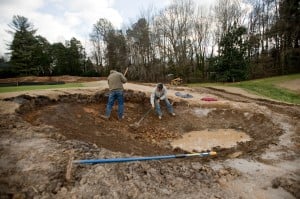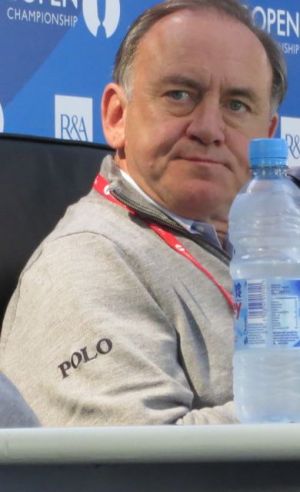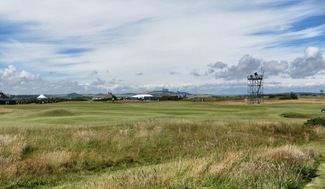When you come to think of it that is the secret of most of the great holes all over the world. They all have some kind of a twist. C.B. MACDONALD
Where The Turf Meets The Turf: Musselburgh Golf & Racing
/"I can remember walking from campus to Old Town with my golf bag to go play."
/John Dell files a super story on Bill Coore and team restoring Old Town Club, a private Perry Maxwell-designed club course he played while at Wake Forest.
 There is also an accompanying video by Dell who interviews superintendent O'Neil Crouch and showing some of the construction process.
There is also an accompanying video by Dell who interviews superintendent O'Neil Crouch and showing some of the construction process.
In his restoration, Coore used old aerial photos found by club members to get an idea of what the course looked like in 1939. The photos showed the original design, but the course had lost some of its character because of time and change.
This was also encouraging to read:
“He’s so busy and has so many projects that if we would have waited, he wouldn’t have been available until 2016,” said head pro Jim Holt, who has been at Old Town since 1979.
A Noodle Bowl Island Green And Man-Made Gale Force Winds
/AT&T SVP: We Want A Non-Profit Architect For Our $150,000 Membership Course In Dallas
/AT&T Senior Vice President Ron Spears, heading up the Trinity Forest project in South Dallas that hopes to get some government breaks and host the Byron Nelson someday, is insisting that architects and the project manager of the new semi-private club in south Dallas work on a non-profit basis.
Why? Because they've lumped a First Tee onto the project and the club is a non-profit.
Because they've lumped a First Tee onto the project and the club is a non-profit.
Rudolph Bush in the Dallas Morning News reports the remarks from Spears.
“No one gets to make a profit out of this. That’s been our intent from the beginning in the way we thought about putting it all together.” Spears said. “This is a not-for-profit in every way.”
So sweet hearing a corporate officer preach the gospel of non-profiteering! And...
Senior officials at AT&T and SMU have not yet selected an architect or project manager. But Spears said he is making it clear to anyone who wants to be involved that they can cover their time and costs and nothing else.
“If you don’t buy into the mission of the club, then it may not be the club for you,” he said. “This is not something for a bunch of rich people. We’re trying to do something good for the city of Dallas, for the kids of South Dallas and to help SMU bring a national championship to Dallas.”
And the First Tee of course is at the heart of this plan...
Spears, though, indicated that the club is intended to operate in a more open and inclusive way than many of the exclusive private courses that host professional golf’s most prestigious tournaments.
The inclusion of First Tee of Dallas will help ensure that, he said.
And that’s going to be attractive to architects and project managers who Spears has already spoken to, he said.
“People are looking at it and saying, ‘I really want to get involved in something for a change that is not just a bunch of guys with lots of money building a toy for themselves,’” he said.
And how, with $150,000 memberships for the "semi-private" club, is this not a bunch of guys with money building a toy for themselves?
Thankfully, Spears and friends will pay and pay dearly for this approach.
They won't get an architect who works on the Coore/Crenshaw model of a modest fee while paying for their shaping team which works in lieu of a primary contractor.
Instead, AT&T will get an architect who puts together big pretty plans, announces he'll work for free because his life is devoted to charity as said architect then creates an arrangement with a contractor or requires the use of his preferred contractor, making his money through a side deal. Sadly, this arrangement was all too common in the Roaring 90s and led to costly change orders that only enriched the architects further.
Ultimately, assuming the quality architects demand their very reasonable fee, Trinity Forest will go the way of so many others and leave Dallas with an overbuilt, over-budget, underwhelming mess.
R&A Chief Architect Dawson: Anchoring Ban Distracted Us From Announcing Most Extensive Old Course Changes In A Century
/Adam Lawrence previews a more extensive story he has coming in Golf Architecture following a tour of the controversial renovations with R&A architect Peter Dawson. Apparently, Martin Hawtree is using this time to renovate the Old Course...to be somewhere else. His hands-on attention to detail is quite impressive is it not?
Anyway, seat belts on. It's cringeworthy time...
But, though he acknowledges the communication of the works could have been handled better – “We were perhaps a little distracted by the announcement of the ban on anchoring”
 Whoa, whoa, whoa...this renovation was in the works for seven months! It involves the most historic course on the planet and the R&A Chief was distracted by the anchoring ban?
Whoa, whoa, whoa...this renovation was in the works for seven months! It involves the most historic course on the planet and the R&A Chief was distracted by the anchoring ban?
On a serious note, if you are too distracted to publicly share the master plan, the Photoshopped images simulating the proposed changes and from sharing a basic notice to the golfers in town of planned changes as you did in 2009 with the Jubilee Course, are you maybe a little too distracted to be implementing architectural changes to the oldest and most cherished venue in the world of sport?
Anyway, before I interrupted...
Dawson is firm in his belief that the works will improve the course, both for day to day play and in championship mode, and that, far from being untouched for hundreds of years, the course has repeatedly been changed, though he agrees that the current works are the biggest in a century.
A century! Well at least he knows his place in history.
Again, the biggest changes in a hundred years earned a Friday news dump press release followed by work on a Monday morning.
And, although he is happy to confirm that the impetus from the works came from the R&A's Championship Committee, he is at pains to explain that toughening the course for the professionals is not the sole goal of the works. Of the filling up of the hollow in the middle of the seventh fairway, he said: “That is something the Links Trust has been keen to do for many years. It collected so many balls, and was thus so full of divots that it had to be roped off and played as ground under repair for a large part of the year, which was a bit of an embarrassment.”
Now, in the old days, so the legend goes, when divots or rabbits burrowed, they often evolved into bunkers? Robert Hunter wrote lovingly about this in The Links (note to Peter and Martin: it's a book on golf architecture, you might enjoy it.)
So wouldn't a more historically accurate change have been to put a bunker in this 7th fairway hollow? Just saying...
Dawson talks at length--because Hawtree was apparently busy with a more pressing project--about the second hole changes, but that'll have to be in a separate post. (I know you can't wait.)
This is just mind-boggling:
On the fourth hole, the low dune formation that creates the left edge of the fairway in the drive zone is planned to be reduced next winter. “Personally I am not sure about that change, and I'm glad it isn't in the first phase, so we have more chance to think about it,” said Dawson.
The architect doesn't even like his own changes.
“The impetus has come from the greenkeepers – it was covered in rough during the 2005 Open, and the result was that almost nobody tried to hit their drive up the right. To create more width, we shaved the bank down in 2010, but it is very steep, and the greens staff have difficulty mowing it at that height.”
I'm just going to ignore the depressing notion that the greenkeepers are making suggestions related to strategy, and try to figure out which mound, excuse me, "acute spur formation," is under attack here. Dawson seems to first be talking about the large leftside grassy mound (pictured below), but how its height would discourage someone from driving down the gorse-lined right side is beyond me. I'm going with the gorse being the problem in that case.
Your honor, I submit to you a photo from 2010:
 4th hole center fairway view (click to enlarge)Then he's talking about the bump short of the green, which I take to be the acute spur formation that the maintenance crew can't mow. Your honor, I submit...
4th hole center fairway view (click to enlarge)Then he's talking about the bump short of the green, which I take to be the acute spur formation that the maintenance crew can't mow. Your honor, I submit...

Pretty amazing after 400 years, and "before mowers were properly invented," that this bump was able to be cut. Maybe those modern mowers aren't that proper after all?
I thought this was a stretch regarding the 11th green:
“That pin is only used in winter at the moment,” said Dawson. “It's not just a question of being unusable at Open speeds – it can't be used even when the greens are at normal summer pace. The green would have to be slowed to six or seven on the Stimpmeter to make that pin usable.”
So the greens slow down four to five feet on the Stimpmeter during winter?
And it seems they are accentuating a feature on the Road hole, because that 4.6 scoring average last time wasn't enough.

The widening to the right is frankly relatively uncontroversial – it will now gather shots from slightly further out. To my eye more surprising is the addition of a slight gathering contour on the left side of the bunker, presumably to make the shot to the back left of the green – a route popularised in the 1990s by Nick Faldo – more challenging. This looks fine from the fairway, but from the eighteenth tee, a slight mound can be seen, which appears a little out of place.
Eh no one will notice. It's just the Road hole!
Meanwhile, Graylyn Loomis posted some high quality images of the work in progress.
Minimalism Coming To Dallas, And Other Changes To The Nelson?
/With AT&T becoming the new title sponsor of the Byron Nelson Championship in 2015, and the tournament likely to move to a new golf course designed by a minimalist to be determined, there are several storylines here.
- The PGA Tour announces a new sponsor while the current sponsor has two years left on their deal. That has to be fairly unprecedented, no?
- The many-times-renovated TPC Four Seasons Resort is a lame duck venue, even after a recent renovation supervised by the PGA Tour. D.A. Weibring was the most recent designer to attempt resurrecting the course.
- This would seem to end any chances of AT&T's long term interest in the "National" event at Congressional in conjunction with the Tiger Woods Foundation.
- The Friday news came on the same day an AT&T representative and some other suits announced a plan to build a golf course in southern Dallas, which will benefit SMU and eventually, the tournament along with a First Tee facility.  There is no truth to the rumor that the phone call listeners erupted in laughter when the Commish said "the odds are quite high," that with support from the Salesmanship Club the Nelson could find a new home.
There is no truth to the rumor that the phone call listeners erupted in laughter when the Commish said "the odds are quite high," that with support from the Salesmanship Club the Nelson could find a new home.
Candace Carlisle described the project this way:
The 400-acre golf course development will include an 18-hole championship golf course, a nine-hole short course, an administrative and teaching facility, a practice facility, and a practice academy for Southern Methodist University students. The golf course will anchor the university's golf program and there's plans to pony up a significant investment in the project, said President R. Gerald Turner.
Bill Nichols says "AT&T officials have already interviewed several renowned golf course architects, including Coore & Crenshaw, Tripp Davis and Associates and Tom Doak’s Renaissance Design."











